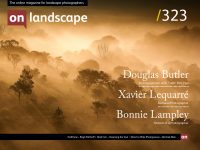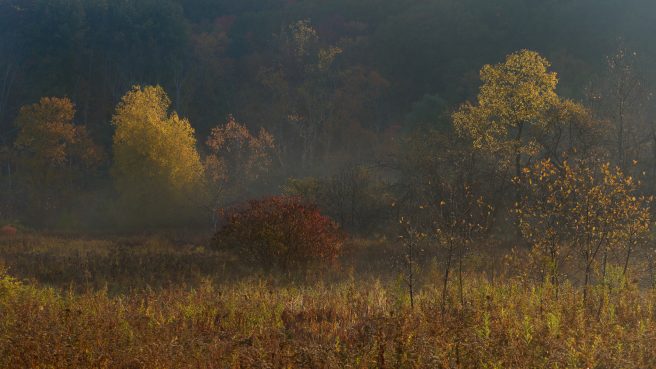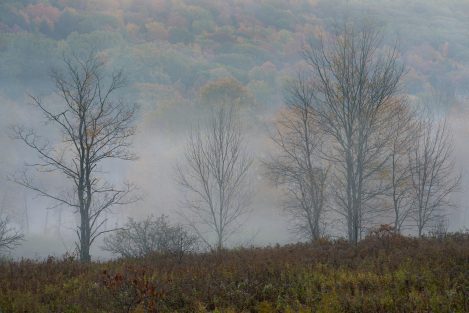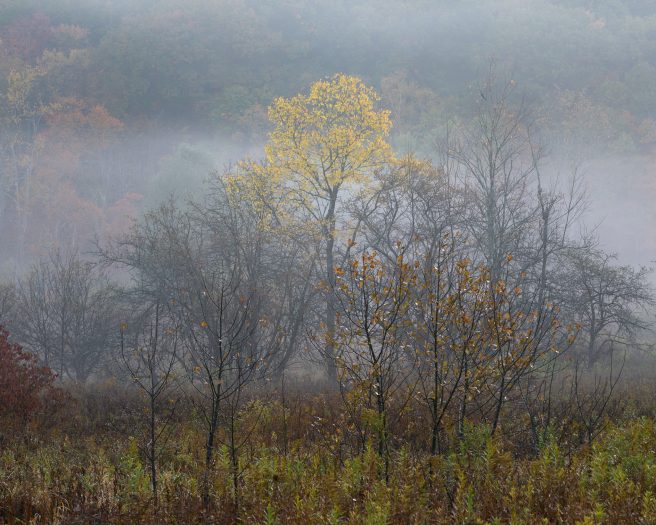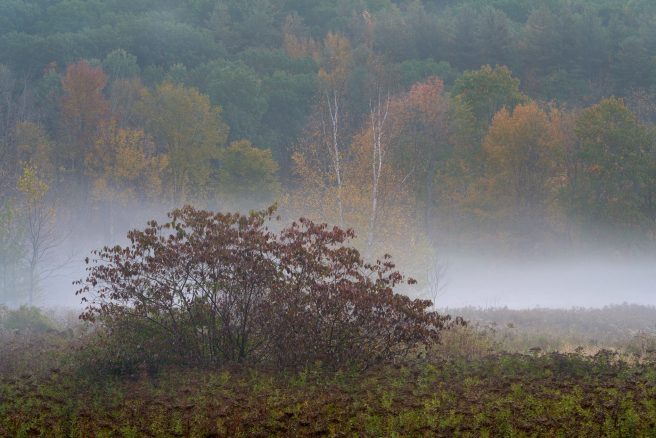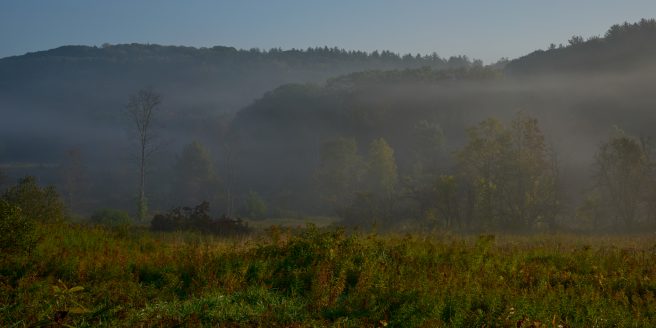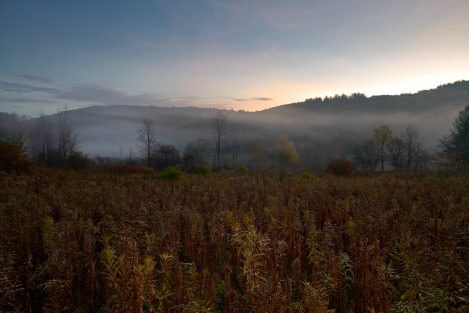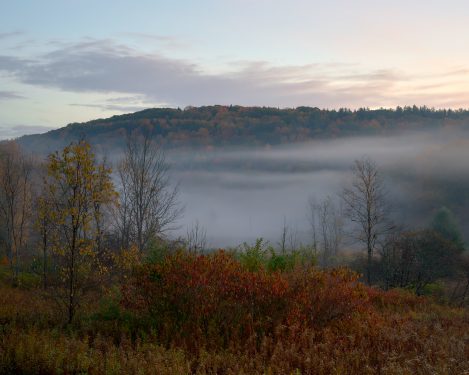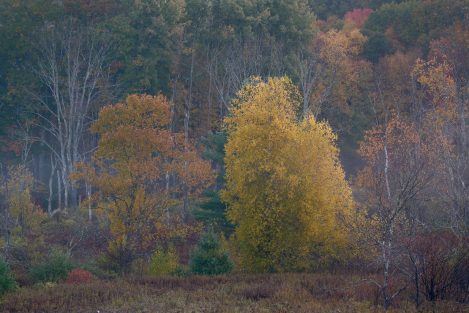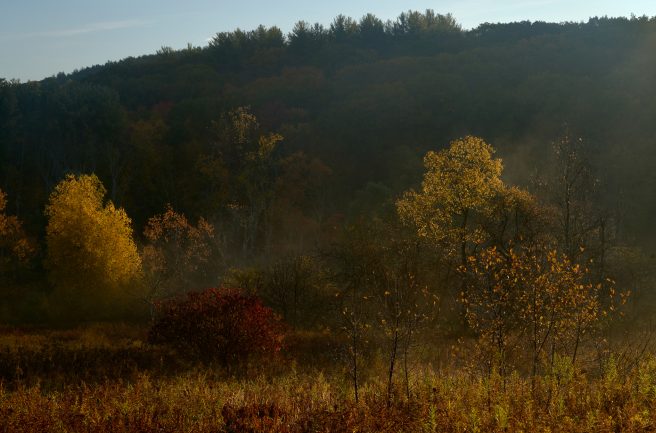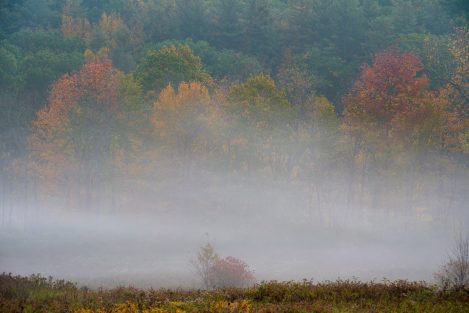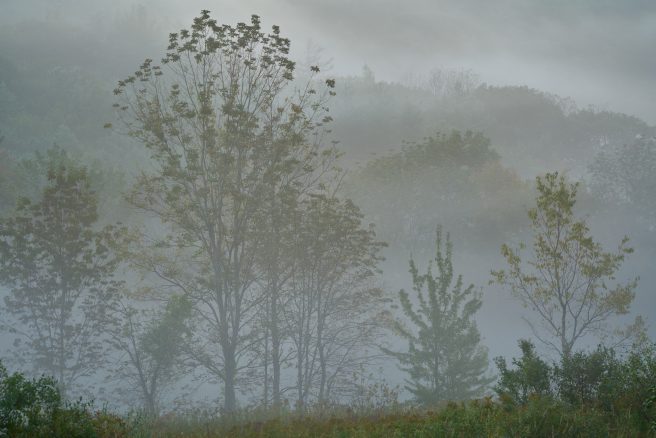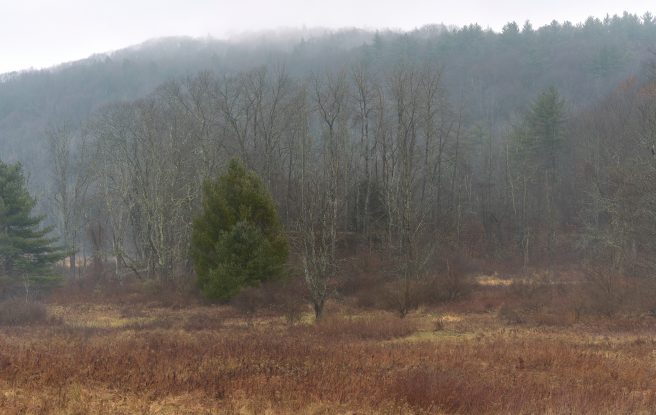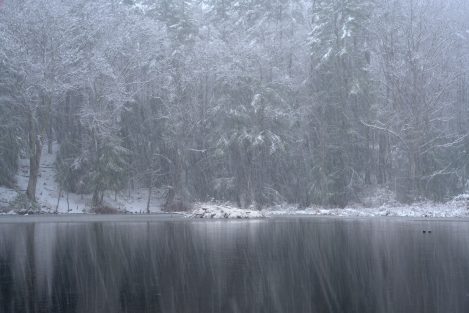Place

Douglas Butler
Doug is a legal aid attorney living with his wife, Jen, in the Pioneer Valley of Western Massachusetts where he enjoys exploring the region, making images and writing.
[One may] discover how new and beautiful the familiar can be if we actually see it as though we had never seen it before. ~ Joseph Wood Krutch
The local is the only universal, upon that all art is built. ~ John Dewy
In Part One, I offered a roadmap of sorts that I suggest could lead anyone to artistic discovery in expressive image making and creative engagement generally. Here, I explore my journey along that map through my relationship built over years of engagement with a nearby wildlife refuge.
Engagement with Place and Place
Joe Cornish in his masterful Scotland’s Mountains, A Landscape Photographer’s View, described his engagement with Scotland’s “heart and soul . . . its mountainous landscape.” In his introductory essay, Cornish explains that, with respect to his image making, “My goal has been a feeling for place, for mood, depth, intimacy, grandeur, beauty.”
One foundational aspect of form in expressive landscape image making must be place. Place is typically integral to most of the outcomes we landscape photographers seek. Even for intimate landscape images, Place has its place. Ultimately, we strive to present to the viewer our interpretation of, engagement with and emotional responses to the places we go, whether or not we reveal or make recognisable those places in our images. We do this, in part, in order to arouse in the viewer an engagement with and an emotional response to an image—their own interpretation of our experience in that place.
We do this, at a basic level, to transform an image from a deliberate documentary representation of a place into a presentation of our intention to create something more, that is, to make art. Critical to best achieving the presentation of our interpretations to a viewer, image makers must, at a fundamental level, unreservedly engage with the places in which we work. In order to foster and grow our relationships with the places we go, that engagement must go beyond that afforded merely through the intermediaries of camera and lens. As Cedric Wright put it, “to try to cover the relationship of photography to our serious reactions to nature” remains “the most important considerations” when image making. As a result, our relationships with Place and the places we go warrant diligent and continual examination.
Place is a cornerstone of the form that circumscribes, fundamentally, all outdoor expressive image making. Though exceptions abound, as a documentary instrument, the camera must adhere to a certain, if not nearly comprehensive, fealty to the “reality” of what is encountered on the other side of the lens. Of course, that fealty is fundamentally informed by “how film sees the world” so to speak—a foundational aspect of form. However, because of that fealty, we are bound to a considerable degree within the “reality,” that is, the form, of the places we encounter when image making. From the scenery to weather and atmosphere, to the topography and accessibility, to seasonal changes of rebirth in spring, summer’s boom, the decay of autumn and winter’s icy deprivation, these aspects of place literally frame our efforts.
For those of us who, over time, visit and revisit the same places again and again, we do so in lockstep with the incessant march of entropy, where blemishes of time appear and leave scars that add or take away from the character of the face of the land. Even after we leave with our data, analog or digital, we are bound by the place from which it came as we move to the next phases of attaining the outcomes we desire as image makers. While processing an image one may be able to remove or even add features and qualities lacking in the field, we certainly are not afforded the latitude of J.M.W. Turner or Richard Wilson or Thomas Cole—or any other landscape painter—and must adhere to a relatively great degree to what was or was not present in the field. Exceptions abound to this statement and the degree of allegiance to the “reality” of any given place any image maker carries through to the final image, print or digital, is a wholly personal aspect of form.
Nevertheless, Place is more than the physical space—the landscape—from which we build images. Place encompasses all that is beyond the lens at any given time—including the image maker—and includes one’s relationship and engagement with those places, beyond that of mere image making. It involves not only those things listed above that you can see, but the history of the place, the uses put to it, if any, and any threat or benefit those uses pose to a place.
Creative engagement with a place encompasses one’s ability and desire to leave or bring with them into the frame, into the image, their expectations, thoughts, emotions, sentiments and history—photographic and otherwise—with that place. In expressive image making, the importance of the attributes of any given place to the process and the outcome achieved are, to a relatively great degree, up to the image maker and the circumstances they face when setting out to make images. All these and more encompass the essence of Place in expressive image making. This process, this engagement with Place is part and parcel of the form that must be examined, made familiar to the point of intimacy, and that we must strive to master in order to push our photography to the realm of magic beyond the “wildest edge of edges.” But how? The inimitable nature writer Barry Lopez, in his short essay A Literature of Place, provides a wealth of insight into fruitful engagement with Place and the places we go.
Lopez was “a lyrical writer who steeped himself in Arctic wildernesses, the habitats of wolves and exotic landscapes around the world for award-winning books that explored the kinship of nature and human culture.” Author of the acclaimed Arctic Dreams: Imagination and Desire in a Northern Landscape, Lopez, in A Literature of Place, submits that,
If you're intimate with a place, a place with whose history you're familiar, and you establish an ethical conversation with it, the implication that follows is this: the place knows you're there. It feels you. You will not be forgotten, cut off, abandoned. . . . How can a person obtain this? How can you occupy a place and also have it occupy you? How can you find such a reciprocity? The key, I think, is to become vulnerable to a place. If you open yourself up, you can build intimacy. Out of such intimacy may come a sense of belonging, a sense of not being isolated in the universe.
Significantly, with respect to my efforts concerning engagement with Place and the places where I make images, Lopez adds that,
A succinct way to describe the frame of mind one should bring to a landscape is to say it rests on the distinction between imposing and proposing one's views. With a sincere proposal you hope to achieve an intimate, reciprocal relationship that will feed you in some way. To impose your views from the start is to truncate such a possibility, to preclude understanding.
This is a frame of mind I try to bring into my relationships with and my work in all places I visit including Poland Brook Wildlife Management Area, where the images included here and with Part One were made. Poland Brook is an area I have visited scores of times since I first went there in the summer of 2020, only a fraction of which outings resulted in any effort at image making. For me, it has been the feelings and emotions evoked when in places with which I have forged such relationships that I have been drawn to most of my life. When in them, including Poland Brook, I pursue the vulnerability Lopez speaks of so as to build an intimacy and form a reciprocity that can only serve to enhance my experience and find “a sense of belonging, a sense of not being isolated in the universe.”
Beginnings
It is Lopez’ belief that “a human imagination is shaped by the architecture it encounters at an early age.” He notes that “The visual landscape, of course, or the depth, elevation, and hues of a [land]scape play a part here, as does the way sunlight everywhere etches lines to accentuate forms.” For Lopez, the visual landscape’s role is not singular in the development of one’s imagination from an early age. “The way we imagine is also affected by streams of scent flowing faint or sharp in the larger ocean of air; by what the North American composer John Luther Adams calls the sonic landscape; and, say, by an awareness of how temperature and humidity rise and fall in a place over a year.” If we credit Lopez, my imagination was molded by the fact that early in my life, before, at the age of 9, a family move entombed me in the confines of an urban landscape, I encountered the rural settings in which my family lived both in upstate New York and later in the northeast corner of Massachusetts wedged between the New Hampshire border and the Merrimack River.
From my earliest memories, we lived in a farmhouse on a nonoperational farm in the rolling countryside of Stillwater, New York. On three sides of the house were unmanaged fields overrun with thickets of bramble amid overgrown grasses, weeds and wildflowers. The fields were peppered with dilapidated outbuildings, a mouldering bulldozer and a very old car somehow embedded, upside down, in a small, dirt cliffside. Beyond, the farm was bounded to the west and north by acres of forest through which a fire road edged with blackberry bushes led to Plum Creek.
My earliest memories come from this place, the “architecture” that I encountered during the reverie in my wandering and play with my brothers in the expanse of the terrain surrounding our home, shaped the imagination that shapes my image making today. Hour upon hour we roamed, and we rambled, wholly unsupervised living in the only house for miles on a street with few passersby. Summer play, bounded only by our imaginations—and the road running by our house—was embroidered with the sonic landscape of birdsong. The rhythmic “cheery, cheery, cheery, cheery, cheer, cheer” vocals of the American Robin, ever accompanied by the chirpy, “see bee, see bee” backing of the Black-capped Chickadee and the melancholy croon of the Mourning Dove’s “hooOOA, hoo, hoo, hoo.” And from the balcony of the upper branches of the Sugar Maples sentineled before our home, the heckling of the Crow’s “caw, caw, caw, caw, caw!” rounded out the soundtrack to our juvenile melodrama.
Scents varied from season to season and place to place in the acreage we wandered, our sensory experiences defined by where we went, when we went and what we did in the land. Loam and an earthy, damp heaviness scented the air in spring from soil upturned for the corn’s impending procession, an aroma that returned more pungent with fall’s decay. The appearance of sweet grassy aromas in the spring and summer morphed into a sharpish, woody tang wafting in the air after the fall reaping of the little bluestem, Indiangrass and switchgrass in the meadow to the south of our house. Summer brought fragrances of golden rod, common milkweed and Queen Anne’s lace, whose subtle aromas demanded from me the same intimacy of a flitting Monarch butterfly in order to appreciate their elusive scents: licorice, a delicate vanilla and a fresh carroty smell, respectively.
After a summer rain, a concoction of moist freshness spiked with the electric tang of ozone permeated the air, greeting us as we bolted from the confines of the house. Winter’s knife-sharp cold scraped our nostrils with an astringent paucity of odor that amounted to an aroma as distinct as any, escaping our faces in an atmospheric vapor.
Undoubtedly my imagination was shaped by these surroundings, by the “architecture” I encountered outside my door. But it was one incident in particular that took place mere steps from that door that has left an indelible mark on me, becoming a runestone stood in my imagination to this day, inscribed with the otherworldly wonder, magic and majesty that one may encounter in even the most familiar and ordinary of places. It was Easter Sunday. I couldn’t have been more than 5 or 6 years old. We boys glumly readied for church, the delight of leaving church with a memento of a woven palm cross the week before a distant memory, the doldrums of a lengthy sermon in the offing. As we boys dribbed and drabbed out of the house and onto the porch, waiting for our adult subjugators, a cool springtime air, fragrant with the season, and laced with a foggy mist, blanketing the countryside, rendering much of it hidden.
As we stood on the porch, shuffling our feet and fidgeting with tight collars and clip on ties, we heard a distant, rhythmic rumble, soothing in its cadence as it neared, its source concealed in the haze. The rumble became ever louder hinting at menace and intrigue to my young mind. I walked down the porch steps, stood in the gravel driveway, and stared into the blank face of fog as the rumble neared. Like lightening incongruously following thunder, the approaching roar entered my body through the soles of my feet, surged upward, through my tremulous legs and set up shop in my stomach, fluttering the wings of butterflies uncocooned. Mere feet from where I stood, the mist was split by the regal muzzle of an unbridled horse, its wild main flailing over a brindled, bobbing neck. Like chiseled marble in motion, its muscled haunches clenched a tail that thrashed in front of an ensemble of cohorts—a conductor’s baton leading an orchestra of chaos. Frozen in place, rooted as a runestone by a grave, the string of horses, too numerous for my young mind to comprehend, split and flowed around me like rapids around a stone, all force and brawn in roaring, cacophonous movement, regimented yet frenzied, sublime and unconstrained by even the hint of domesticity, disappearing into the fog once again.
Even though I cannot doubt now that those horses, surely fewer than I believed then, were steeds of a local farmer escaped from a nearby stable, the legend of the wild horse stampede engulfing me on a foggy Easter morning remains as a reminder to expect the unexpected even in your own yard.
Gaining Intimacy
Lopez’ offers practical advice as to how to go about fashioning a meaningful experience in and forging a reciprocal relationship with any place. It is advice that I and, I am sure, many have followed to a degree innately while engaging with the places in which we make images. It is advice that should form the bedrock of any excursion into any “geography” whether local or far flung, near field or far field.
How does one actually enter a local geography? . . . To respond explicitly and practicably, my first suggestion would be to be silent. Put aside the bird book, the analytic state of mind, any compulsion to identify, and sit still. Concentrate instead on feeling a place, on deliberately using the sense of proprioception. Where in this volume of space are you situated? The space behind you is as important as what you see before you. What lies beneath you is as relevant as what stands on the far horizon. Actively use your ears to imagine the acoustical hemisphere you occupy. How does birdsong ramify here? Through what kind of air is it moving? Concentrate on smells in the belief you can smell water and stone. Use your hands to get the heft and texture of a place—the tensile strength in a willow branch, the moisture in a pinch of soil, the different nap of leaves. Open a vertical line to the place by joining the color and form of the sky to what you see out across the ground. Look away from what you want to scrutinize in order to gain a sense of its scale and proportion. Be wary of any obvious explanation for the existence of color, a movement. Cultivate a sense of complexity, the sense that another landscape exists beyond the one you can subject to analysis.
Lopez concludes that “The purpose of such attentiveness is to gain intimacy, to rid yourself of assumption.” His summation that “it should be like a conversation with someone you're attracted to, a person you don't want to send away by having made too much of yourself,” resonates whenever I am in Poland Brook and other such places. My time in the local geography proves to me that “such conversations take place simultaneously on several levels.” I too have found that such conversations “may easily be driven by more than simple curiosity,” and that the forces that drive me to such engagement are much deeper, sustaining and compelling than mere inquisitiveness. And while I share the “compelling desire, as in human conversation . . . to institute a sustaining or informing relationship” with any given place, I seek also to feed my imagination so as to make something from the intimacy gained. [widepullquote]For, like Lopez, the relationships I have forged with the places in which I make images have established in me an unshakable faith that “the power of the human imagination to extrapolate from an odd handful of things—faint movement in a copse of trees, a wingbeat, the damp cold of field stones at night—the human ability to make from all this a pattern, to compose a story out of it fixes in me a sense of hope.”/widepullquote]For, like Lopez, the relationships I have forged with the places in which I make images have established in me an unshakable faith that “the power of the human imagination to extrapolate from an odd handful of things—faint movement in a copse of trees, a wingbeat, the damp cold of field stones at night—the human ability to make from all this a pattern, to compose a story out of it fixes in me a sense of hope.”
Here is where I could tell you about the ethereal echo of the rumble of those stampeding hoof beats that remains with me to this day. An echo that surges up from the soles of my feet, through my legs, across my midriff, lodging a lump in my throat when I am nowadays stood waist high in golden rod, the sun only a hint above the ridge, awaiting the intimate subtle stampede of murmurs and whispers of the sustaining and sustained conversation with Poland Brook Wildlife Management Area to manifest through the fog I carry within. But alas, the magic of such conversations with good friends, the power that resonates within from having had them, diminishes or disappears altogether in the strict retelling. And worse, like gossip, can leave the relationship unsteady, threatening to send Poland Brook away from me by having made too much of myself in the retelling. Some conversations are just private. But the outcomes, the benefits of having those conversations, the benevolence taking root, that I am made better by having such conversations, and the stories that I have made from them in my images must be shared. “We keep each other alive with our stories,” Lopez tells us. “We need to share them, as much as we need to share food.”
Do you have an article idea that you're interested in getting published or a project you've been working on? We are always keen to get submissions, so please get in touch to discuss your idea.

